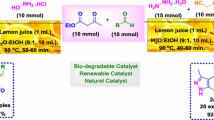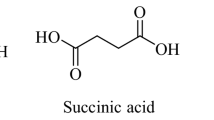Abstract
Extracts from various vegetables and fruits were investigated for their abilities to reduce nitro-polycyclic aromatic hydrocarbons (NPAHs). The extracts from grape and onion exhibited an interesting selectivity, yielding corresponding hydroxylamines or amines as major products under mild conditions of 30 °C and pH 7.0. Grape extracts reduced the 4-nitro-1,8-naphthalic anhydride with the highest conversion rate (>99%) and the highest ratio of hydroxylamine to amine (95:5). In contrast, the onion extracts reduced 4-nitro-1,8-naphthalic anhydride with a conversion rate of 94% and a ratio of hydroxylamine to amine of 8:92. The thiol-reducing agent, β-mercaptoethanol, and metal cations, Ca2+ and Mg2+, greatly increased the reductive efficiency. This work provides an alternative strategy for biotransformation of nitro-polycyclic compounds.
Similar content being viewed by others
References
Abhilash, P.C., Jamil, S., Singh, N., 2009. Transgenic plants for enhanced biodegradation and phytoremediation of organic xenobiotics. Biotechnol. Adv., 27(4):474–488. [doi:10.1016/j.biotechadv.2009.04.002]
Castelli, F., Micieli, D., Ottimo, S., Minniti, Z., Sarpietro, M.G., Librando, V., 2008. Absorption of nitro-polycyclic aromatic hydrocarbons by biomembrane models: effect of the medium lipophilicity. Chemosphere, 73(7):1108–1114. [doi:10.1016/j.chemosphere.2008.07.023]
Dai, R., Chen, J., Lin, J., Xiao, S., Chen, S., Deng, Y., 2009. Reduction of nitro phenols using nitroreductase from E. coli in the presence of NADH. J. Hazard. Mater., 170(1):141–143. [doi:10.1016/j.jhazmat.2009.04.122]
Doran, P.M., 2009. Application of plant tissue cultures in phytoremediation research: incentives and limitations. Biotechnol. Bioeng., 103(1):60–76. [doi:10.1002/bit.22280]
Dua, M., Singh, A., Sethunathan, N., Johri, A.K., 2002. Biotechnology and bioremediation: successes and limitations. Appl. Microbiol. Biotechnol., 59(2-3):143–152. [doi:10.1007/s00253-002-1024-6]
Hallas, L.E., Alexander, M., 1983. Microbial transformation of nitroaromatic compounds in sewage effluent. Appl. Environ. Microbiol., 45(4):1234–1241.
Haritash, A.K., Kaushik, C.P., 2009. Biodegradation aspects of polycyclic aromatic hydrocarbons (PAHs): a review. J. Hazard. Mater., 169(1-3):1–15. [doi:10.1016/j.jhazmat.2009.03.137]
Laine, D.F., Cheng, I.F., 2007. The destruction of organic pollutants under mild reaction conditions: a review. Microchem. J., 85(2):183–193. [doi:10.1016/j.microc.2006.07.002]
Lewis, N.A., Ray, A.M., 1984. The effect of anions on redox reactions. Inorg. Chem., 23(22):3649–3653. [doi:10.1021/ic00190a044]
Macek, T., Mackova, M., Kas, J., 2000. Exploitation of plants for the removal of organics in environmental remediation. Biotechnol. Adv., 18(1):23–34. [doi:10.1016/S0734-9750(99)00034-8]
Marvin-Sikkema, F.D., de Bont, J.A., 1994. Degradation of nitroaromatic compounds by microorganisms. Appl. Microbiol. Biotechnol., 42(4):499–507. [doi:10.1007/BF00173912]
Matsuda, T., Yamanaka, R., Nakamura, K., 2009. Recent progress in biocatalysis for asymmetric oxidation and reduction. Tetrahedron: Asymmetry, 20(5):513–557. [doi:10.1016/j.tetasy.2008.12.035]
Medina, V.F., Larson, S.L., Agwaramgbo, L., Perez, W., Escalon, L., 2004. Treatment of trinitrotoluene by crude plant extracts. Chemosphere, 55(5):725–732. [doi:10.1016/j.chemosphere.2003.12.014]
Muck, A., Kubát, P., Oliveira, A., Ferreira, L.F.V., Cvacka, J., Civis, S., Zelinger, Z., Barek, J., Zima, J., 2002. Photodegradation of 1-nitropyrene in solution and in the adsorbed state. J. Hazard. Mater., 95(1–2):175–184. [doi:10.1016/S0304-3894(02)00120-6]
Parrish, Z.D., Banks, M.K., Schwab, A.P., 2004. Effectiveness of phytoremediation as a secondary treatment for polycyclic aromatic hydrocarbons (PAHs) in composted soil. Int. J. Phytorem., 6(2):119–137. [doi:10.1080/16226510490454803]
Ramos, J.L., González-Pérez, M.M., Caballero, A., van Dillewijn, P., 2005. Bioremediation of polynitrated aromatic compounds: plants and microbes put up a fight. Curr. Opin. Biotechnol., 16(3):275–281. [doi:10.1016/j.copbio.2005.03.010]
Roldán, M.D., Pérez-Reinado, E., Castillo, F., Moreno-Vivián, C., 2008. Reduction of polynitroaromatic compounds: the bacterial nitroreductases. FEMS Microbiol. Rev., 32(3): 474–500. [doi:10.1111/j.1574-6976.2008.00107.x]
Schackmann, A., Muller, R., 1991. Reduction of nitroaromatic compounds by different Pseudomonas species under aerobic conditions. Appl. Microbiol. Biotechnol., 34(6): 809–813. [doi:10.1007/BF00169355]
Shen, J., Zhang, J., Zuo, Y., Wang, L., Sun, X., Li, J., Han, W., He, R., 2009. Biodegradation of 2,4,6-trinitrophenol by Rhodococcus sp. isolated from a picric acid-contaminated soil. J. Hazard. Mater., 163(2–3):1199–1206. [doi:10.1016/j.jhazmat.2008.07.086]
Spain, J.C., 1995. Biodegradation of nitroaromatic compounds. Annu. Rev. Microbiol., 49(1):523–555. [doi:10.1146/annurev.mi.49.100195.002515]
Teramoto, H., Tanaka, H., Wariishi, H., 2004. Degradation of 4-nitrophenol by the lignin-degrading basidiomycete Phanerochaete chrysosporium. Appl. Microbiol. Biotechnol., 66(3):312–317. [doi:10.1007/s00253-004-1637-z]
Tocher, J.H., 1997. Reductive activation of nitroheterocyclic compounds. Gen. Pharmacol., 28(4):485–487. [doi:10.1016/S0306-3623(96)00283-2]
van Aken, B., 2009. Transgenic plants for enhanced phytoremediation of toxic explosives. Curr. Opin. Biotechnol., 20(2):231–236. [doi:10.1016/j.copbio.2009.01.011]
Wu, Y., Luo, Y., Zou, D., Ni, J., Liu, W., Teng, Y., Li, Z., 2008. Bioremediation of polycyclic aromatic hydrocarbons contaminated soil with Monilinia sp.: degradation and microbial community analysis. Biodegradation, 19(2):247–257. [doi:10.1007/s10532-007-9131-9]
Yoon, J.M., Aken, B.V., Schnoor, J.L., 2006. Leaching of contaminated leaves following uptake and phytoremediation of RDX, HMX, and TNT by poplar. Int. J. Phytorem., 8(1):81–94. [doi:10.1080/15226510500507128]
Author information
Authors and Affiliations
Corresponding authors
Additional information
Project supported by the National Basic Research Program (973) of China (No. 2010CB126102), the National Natural Science Foundation of China (No. 31070715), the National High-Tech R&D Program (863) of China (No. 2011AA10A204), the National Key Technology R&D Program of China (No. 2011BAE06B05), and the Fundamental Research Funds for the Central Universities (No. DUT10LK33), China
Rights and permissions
About this article
Cite this article
Xie, B., Yang, J. & Yang, Q. Biotransformation of nitro-polycyclic aromatic compounds by vegetable and fruit cell extracts. J. Zhejiang Univ. Sci. B 13, 248–253 (2012). https://doi.org/10.1631/jzus.B1100254
Received:
Accepted:
Published:
Issue Date:
DOI: https://doi.org/10.1631/jzus.B1100254




